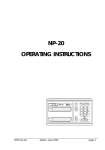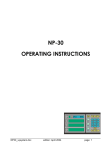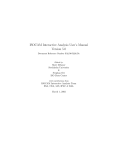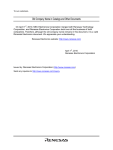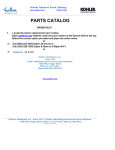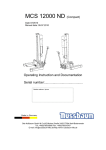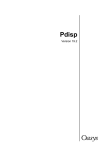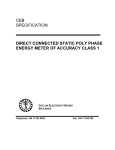Download NP-20 z OPERATING INSTRUCTIONS
Transcript
NP-20 z OPERATING INSTRUCTIONS z 1/2 Zs 1/2 NP20z_ang.doc edition: December 2002 page: 1 © Copyrights 2002 Iskra TELA d.o.o. Printed in Slovenia 2002 NP20z_ang.doc edition: December 2002 page: 2 CONTENTS 1. SCOPE OF DELIVERY .......................................................................................... 5 2. GENERAL DESCRIPTION .................................................................................... 5 3. INSTALLATION AND CONNECTION OF THE DEVICE ...................................... 6 3.1. External dimensions and fastening ................................................................ 6 3.2. Connection ..................................................................................................... 6 3.3. Connectors ..................................................................................................... 7 4. ADJUSTMENT TO THE MACHINE ..................................................................... 10 4.1. Entry of machine parameters ....................................................................... 10 4.2. Entry of technological parameters ............................................................... 14 5. MEASURING FUNCTIONS.................................................................................. 15 5.1 Reference mode............................................................................................ 16 5.1.1. Calibration of absolute position with reference mark ............................ 16 5.1.2. Determination of reference value with reference pulse ........................ 16 5.1.3. Manual entry of reference values in the p90 parameter ....................... 17 5.2.Absolute mode…………………………………………………………………….18 5.2.1. Preset of absolute position ……………………………………………...19 5.2.2. Reset of absolute positions ………………………………………………20 5.2.3. Mm/inch switching-over……………………………………………………20 5.2.4. Radius/diameter switching-over…………………………………………..20 5.2.5. Halve of measured value in z axis………………………………………..21 5.2.6 Freeze of absolute position………………………………………………..21 5.2.7 Datum points (dp00...dp99) ………………………………………………...22 5.2.7.1 Datum point selection………………………………………………22 5.2.7.2 Setting the datum points by position enter ………………………23 5.2.7.3 Datum points setting by manual parameter entry……………….23 5.3.Relative mode………………………………………………………………………24 5.4.Distance to go mode………………………………………………………………27 5.5. Axis shift velocity measuring mode ......................................................... 27 6. SERIAL DATA TRANSFER................................................................................. 28 7. STATUS AND ERROR INDICATION .................................................................. 30 8. TECHNICAL DATA .............................................................................................. 32 OF DELIVERY NP20z_ang.doc edition: December 2002 page: 3 NP20z_ang.doc edition: December 2002 page: 4 1. SCOPE OF DELIVERY Position readout NP-20z for lathes. Possible options: R, K, B. Spare fuse (link) 0.3 A T for 220 V~, i.e. 0.6 A T for 110 V~. Power cable with safety plug for 220 V, 50 Hz and three-pole socket, length 3 m. NOTE: Meanings of options designations: R connector RIE (only for rotary transducers) K interface RS 232 C for serial communication B battery backup 2. GENERAL DESCRIPTION Position can be measured both in transverse and longitudinal axes (X, Z) and in an additional axis (Zo) that is parallel to longitudinal. Position value in the auxiliary axis can be continuously added and is indicated in the position of the related main axis (Z), or can be display separately on the display Zo. X ,Zo and Z displays indicate the absolute or the relative position. When the relative mode is selected in one or in both axes, the related indicator REL is lit. In the relative mode it is possible to measure depending on the relative zero, which can be selected by pressing the key REL in the current position. Incremental linear or rotary measuring transducers with square or sine wave measuring signals are used for position measuring. Built-in "monitoring functions" assure reliable operation, assistance at work and easy troubleshooting of eventual errors in the measuring system or during the operation. If an error occurs a message appears on the appropriate display, indicating the cause for the error, e.g.: pressure on a wrong key (<Err type>), exceeded max. Movement speed (<Err 1>), undetermined parameter (<Err PAr>) etc. The messages are deleted and reception acknowledged by the key DELETE. Position readout NP-20 is optionally equipped with battery backup system. This system assures, in the case of power failure, storage of absolute position in the moment of power failure. When the power is set readout shows the last absolute position before power failure. NP20z_ang.doc edition: December 2002 page: 5 3. INSTALLATION AND CONNECTION OF THE DEVICE 3.1. EXTERNAL DIMENSIONS AND FASTENING S – compact table version 101 250 mm inch Iskra ref D/R rel 150 161.5 X NP 20 Z ref 1/2 rel 60 205 Mounting dimension - M5 P – Panel (Build in) version Panel mounting dimension: 244+0.5 x 145+0.5 Sheet thickness: 1.6 mm max. 250 mm inch Iskra ref 147.5 X NP 20 150 D/R rel 101 Z ref 1/2 rel 243 T – Tabletop version NP20z_ang.doc edition: December 2002 page: 6 250 25 mm ° NP 20 inch X Iskra ref 150 12 72 Z ref 1/2 rel 227 D/R rel 60 205 Mounting dimension - M5 80 ° 99 c – Console version 250 25 Supply Unit Power supply output (5V) mm inch NP 20 Iskra Z ref 1/2 rel 150 D/R rel 60 ref 193 X Power supply input (100~250V) Power switch ON/OFF L 90 O5.6, 4x 100 50 L=150, 200 ... 450 255.4 263.4 Clearance of at least 120 mm has to be provided for accommodating the electrical connections at rear of the device. NP20z_ang.doc edition: December 2002 page: 7 3.2. CONNECTION Correct connection of the device and of the measuring system are very important for reliable operation, especially when the device is applied in strenuous working conditions (close to power cables, inductive load switches etc.). The following basic rules should therefore be observed during the connection of the device: • The housing of the device must always be grounded in the same grounding point as the machine, either via the grounding conductor of the mains power supply cable with safety plug or by connecting a special grounding conductor to the grounding screw at rear of the device. The cross-section of the grounding conductor shall not be less than 1.5 mm², and by the shortest route should be connected to main grounding point of a machine. <1.5mm2 by shortest way to machine ground point • Cables with measuring and control signals of the device (connectors X, Z, Z', RIE, RS232) have to be laid as far as possible from the power cables on the machine and from the other powerful sources of electromagnetic disturbances (relays, contactors, motors, transformers, switch-mode power supply). > 100mm M • > 200mm > 100mm = Inductive sources of disturbance on the machine or in the environment of the device (couplings, relays, magnetic valves etc.) have to be choked by parallelconnecting corresponding standard choking elements (diodes, zener diodes, RC elements for the DC power supplied elements and RC elements for the AC power supplied elements). R Recommended value for protection elements C V C D 125 V dc 220E/5W 2 uF /600V 250 V dc 220E/5W 0.5uF 1000V 115 V ac 220E/1W 0.5 uF /600V 230 V ac 220E/5W 0.5 uF /1000V 440 V ac 220E/5W 0.5 uF /2000V < 60 dc DC relays R R C Switches NP20z_ang.doc R S T M 3 1N4004 Relays and AC motors edition: December 2002 page: 8 3.3. CONNECTORS Axes Connectors for square-wave Encoders: Viewing the rear plate Connector contacts: A B C D E F G H J K L M Connector for RIE switches (option R): Viewing the rear plate Shield (grounding) GND (0 V) Signal A Signal A_ Signal B Not connected Signal RI Signal RI_ Not connected +5 V Signal B_ Not connected Connector contacts: 1 2 3 4 5 6 7 8 9 RIEx RIEz' RIEz Not connected 5V Input RIEz' (auxiliary axis) Input Ryes Not connected Not connected NOTE: The RIE switches are only required when rotary measuring transducers are used. The installation of the switch has to assure that it is only active for the particular reference pulse at which we want to set the reference value (the transducer generates one reference pulse at each rotation). The break contact of the switch is used. Connector for serial interface RS 232 (option K): Viewing the rear plate NP20z_ang.doc Connector contacts: 1 2 3 4 5 6 7 8 9 edition: December 2002 Shield (grounding) RXD input (data reception) TXD output (data transmission) Not connected GND (0 V) Not connected RTS output (Request to send) CTS input (Clear to send) Not connected page: 9 4. ADJUSTMENT TO THE MACHINE 4.1. ENTRY OF MACHINE PARAMETERS The device is adjusted to the machine by entering the appropriate machine parameters. These values are stored in the permanent, non-volatile memory, until the new values are entered. Numbers from P1 to P49 are assigned to machine parameters and higher numbers to technological parameters. Machine parameters can only be set by entering first the value 3.14 (P0 = 3.14) for the P0 parameter. This is the protection code that protects the parameters against unintentional entry or deletion. This code entrance is active until the device is switched off. Use the delete code P0 = 6.28 for deleting all parameters. This is recommendable especially when the installed EPROM circuit is replaced by a new one, i.e. by another software version. The following diagram shows the procedure for calling, monitoring and entering the parameters in different modes of selection, by entering the machine parameter P0=3.14: PROCEDURE: P 3 DISPLAY X: Parameter selection 0 . NOTES: 1 4 P00 codE codE _ _ _ 3.14. Alternate designation/value display. Dashes for "empty" parameter. Value selection, right point is flashing P00 codE 3.14 P01 Incr Value entry, alternate indication of designation and parameter value. Switchover to next parameter. Abandon of parameter settings or reviewing Having entered the protection code, continue entering the remaining machine parameters. When you have set any parameter by pressing the key ENTER, the next parameter appears on the display. In case you do not want to set or change it, press the key ENTER in order to choose the following parameter. For direct selection of a particular parameter, press the key P and enter the parameter number (e.g. P 090). In case of a typing error, press the key DELETE and start again the entry. NP20z_ang.doc edition: December 2002 page: 10 <P01 Incr> The counting direction, the measuring mode, the number of decimal places, and the weight factor by which a measuring increment affects the last digit in the X or Z displays. The weight factor is a fraction with any two or three-digit whole number in the numerator and the denominator (altogether 5 digits). Also the "00" or "000" numbers, meaning 100 or 1000, respectively, are admissible. +A.B.CCC.DD Weight factor. Define influence of one measuring increments to displayed values. Xmeas = (number of increments / DD) *CCC Number of decimal places • Type of measurement: 0 .. Linear measurement 1 ..Angular measurement In decimal format Counting direction: +.. Positive direction - .. Negative direction Weight factor (CCC.DD): Define the influence of measuring increments to displayed values: Xmeas = (number of increments / DD) *CCC Number of increments ………counted number of increments From linear or rotary encoder Xmeas …….……………………. measured value (Number of increments/DD)…. integer representation of divide value without a rest • Number of decimal points (B) Define the number of digits on the right side of decimal point. Can be any number between 0 and 4. • Type of measurement (A) Define the type of measurement 0 ………………………… Linear measurement 1 ………………………… Angular measurement in decimal Format. Counting direction Define the direction of counting, when a positive transition of A signal precede a positive transition of B signal. Empty………………….. Positive direction - ………………………. Negative direction • Examples: Scale resolution NP20z_ang.doc P01 edition: December 2002 Display resolution page: 11 0.5 µm 1 µm 5 µm 0.4.005.01 0.3.001.02 0.3.005.10 0.3.001.01 0.3.005.05 0.2.001.10 0.3.005.01 0.3.010.02 0.2.001.02 0.0005 0.001 0.005 0.001 0.005 0.01 0.005 0.010 0.01 <P03 Lin.c.> The linear correction factor. Values from -65535 to +65535 are admissible. The entered value represents the coefficient in particles per million particles with which the device corrects the measured value before indicating it. Xdisp = Xmeas * ( 1 + P03 * 10-6 ) Xdisp ………………….. displayed value (compensated) Xmeas …………………. measured value P03 ………………….. Value of parameter 3 The zero of the correction line is set by the device in the last written position (PRESET, RESET, absolute position entry by means of RI, relative position entry by means of key REL). EXAMPLE: The last written position is Xp = 100.00 mm, P07 = -10000 (this corresponds to -10000 particles per million particles, i.e. -1%). xd = x + (x - Xp) · P03 · 10-6 For x = 0: xd = 0 + (0 - 100) · (-10000 · 10-6) = +1.00 For X = 200: xd = 200 + (200 - 100) · (-10000 · 10-6) = +199.00 Usage of linear compensation is recommended: • for older machine with bended guide ways with purpose of eliminating Abbe error; • for usage of angular measurement on the rotary table by means of rotary encoder, with purpose to adjust required displayed resolution with encoder’s line number, and gear ratio of rotary table mechanism; In a case if angular measurement on the appropriate axis is selected, and linear o compensation is different then 0, displayed value can be in the range of +(360 o + 15 ), Reason for that limitation is to avoid arithmetical error caused by limited number lengths. NP20z_ang.doc edition: December 2002 page: 12 <P05 doff> <P06 toll> When the digits change too quickly, the last display digits are shaded: P05 = 0: Shading off. P05 = 1: Shading on. Counting error tolerance. P06 = 0: Counting error monitoring is off. P06 = 1..15: Counting error value in measuring increments that causes device error indication <Err 2>. NOTE: Counting error monitoring (patented by ISKRA) is active in the manual mode even when the measuring system is not calibrated by means of the reference value. Every time the reference point on the measuring transducer is passed over, the device measures the reference value and compares it with the reference value recorded at the previous passage over the reference point. In case the values are not equal and the difference between them exceeds the tolerance (P06), the device indicates the error <Err 2>. When this message is deleted, the device also indicates the value of this difference. <P07 232c> Define the baud rate for serial communication interface (option K). Possible values are: 300, 600, 1200, 2400, 4800, 9600, <P08 n.LF> Define the number of empty lines, which are outputs after print out a one message. Possible values are 1 to 50. <P11 Hold> Define the function of key RES : P11 = 0 ……. Key “RES” will reset absolute position of appropriate axis P11 = 1 ……. Key “RES” will freeze (hold) current absolute position of appropriate axis. <P15 dCr> Define type of reference mark used on the measuring encoders for main axes P15 = 0: Standard reference mark. P15 = 1: DCR reference marks NP20z_ang.doc edition: December 2002 page: 13 4.2. ENTRY OF TECHNOLOGICAL PARAMETERS Technological parameters are entered into permanent memory in the same way as the machine parameters except that it is not necessary to enter first the protection code P0 = 3.14. <P90 rEF> Reference value for X or Z axis. In the auxiliary axis the 0 value is assumed automatically. Reference value represent a distance in position (or angular) units from of absolute zero point and reference point on the linear (or rotary) encoder. Reference point in Z axis x Absolute Zero point Reference point in X axis z Ref. value in Z axis Reference value in X axis Ref. value in Zo axis In the case, if Distance coded reference is used Reference value represent a distance in position (or angular) units from zero point of st absolute zero and 1 reference point on the linear (or rotary) encoder. <P101 dP01> Coordinates of the datum point DP1 in the X, Zo and Z-axis. <P199 Dp99>Coordinates of the datum point DP99 in the X, Zo and Z-axis. NP20z_ang.doc edition: December 2002 page: 14 5. MEASURING FUNCTION NP 20 can be set in different modes of operation, performing the proper measuring functions or settings. The conditions which cause transitions between different modes is shown in diagram bellow: Relative mode Reference mode Determination Calibration P Calibration REF (option B) P abs rel abs rel finished REF Switch on procedure 7 8 9 4 5 6 1 2 3 0 +- . Distance to go mode abs rel Absolute mode 0 Parameters settings and reviewing P P 0 1 Velocity measurement Print out Selected mode in which NP 20 temporary operate is marked by indications on the display according to table bellow: Indications Mode Calibration status Ref X or Z Rel Off Off Off Absolute Calibrated Off On Off Absolute Calibrated Off Off On Relative Calibrated Off On On Relative Calibrated On Off Off Absolute Non-calibrated On On Off Absolute Non-calibrated On Off On Relative Non-calibrated On On On Relative Non-calibrated Pulse On Off Reference – Non- calibrated main axis Calibrated auxiliary axis calibration Pulse On Pulse Reference – Non- calibrated main axis Non-calibrated auxiliary axis calibration Pulse Off Off Reference – Calibrated both axes calibration Pulse Pulse Off Reference – Determination of reference determination value NP20z_ang.doc edition: December 2002 page: 15 5.1 REFERENCE MODE If the NP20 is equipped with battery back-up system (option B) , after switch on it is set to absolute mode, REF indications lights steady indicating that absolute position is not calibrated. If user like to calibrate absolute position, he should by pressing to key “REF” enter into the reference mode. If the NP20 is not equipped with battery back-up system (without option B), the device after a switch on is automatically set to the reference mode. Axes indications lights steady, indicating that these axes have not been calibrated. 5.1.1 CALIBRATION OF ABSOLUTE POSITION WITH REFERENCE MARK Calibration of absolute position requires, that device is set to the reference mode, and reference value should be entered into the parameter P90. If reference value has not been entered into P90, when device is set to reference mode, message: “ref ___” will appear on the display of corresponding axis. In that case user should enter reference value by procedure describe in chapters 5.1.2 or 5.1.3. PROCEDURE: DISPLAY NOTES: Entrance in the reference mode calibration; If reference value have not be entered “ref___” is displayed After reference mark is passed display starts to display the position. In the case if auxiliary axis is used, first pass the reference in that axis, and than in main axis. When calibration procedure is finish NP 20 automatically return to absolute mode. REF Pass over the reference points on the encoders 5.1.2. DETERMINATION OF REFERENCE VALUE WITH REFERENCE PULSE It is used when we want to "save" an already selected absolute coordinate system so that we can re-establish it in case it gets lost when the device is switched off or for other reasons. PROCEDURE: DISPLAY NOTES: Set the NP20 to Absolute mode Drive the tool to known position Preset the known position to axes REF P Pass the reference marks on both axis NP20z_ang.doc Shows position Shows position In this point NP 20 is set to the absolute mode Presetting Shows position Use the procedure describe in chapter 5.2.1 Set the NP 20 to reference mode – determination It can be done by turning diameter, and then measure it (by calliper, or micrometer) In the case if auxiliary axis is used, first pass the reference marks in that axis, and after in main axis. NP 20 will inform the receiving of reference mark by sound. After passing of reference mark, NP20 will be set to absolute mode, and reference value will be entered into the P90 edition: December 2002 page: 16 EXAMPLE: Turning Measuring Presetting Determination NP 20 is set to ABSOLUTE mode NP 20 is set in REFERENCE mode X 20.000 z 20.000 x x Z 0.000 z REF P x x z z 5.1.3. MANUAL ENTRY OF REFERENCE VALUES IN THE P90 PARAMETER This mode is generally used only for testing, e.g. when we want to enter the zero reference value in both axes: NOTE: Do not enter the parameter for the auxiliary axis as it automatically assumes the zero value. NP20z_ang.doc edition: December 2002 page: 17 5.2. ABSOLUTE MODE Absolute mode is basic operation mode of NP 20. In this mode NP 20 display the absolute position, which can be calibrated or non-calibrated in this mode it is possible to switch display of Zo axis to be displayed separately or added with axis Z. 40 z X ref R rel 5.000 1/2 Zo ref rel 25.000 Z ref rel 15.000 1/2 X ref R rel Zs 5.000 Zo ref rel 1/2 Z ref rel 1/2 40.000 x Zo 5 Z 0 0 5 10 15 20 25 5 10 15 20 25 30 If NP 20 is set to any other mode of operation, it will be returned to absolute mode after specified task in the other mode is performed. In the absolute mode is possible to preset the absolute position, reset the absolute position, switch over the metric or inch measuring units, switch over the radius or diameter position display in tool axis, halving the measured value in longitudinal axis, operate in a different datum points or preset datum points value. Separate display of Zo axis is very useful, in the case when taper’s shape should be machined. z X ref R rel 5.000 1/2 Zo ref rel 25.000 Z ref rel 15.000 1/2 x Zo Z NP20z_ang.doc edition: December 2002 page: 18 5.2.1. PRESET of ABSOLUTE POSITION The absolute position of the measuring system can be selected optionally, by manually entering the axis position value. First select the axis (the axis indicators is lit) then the position value (the right decimal point on the axis display is flashing) and then confirm the entry by pressing the key ENTER (the right decimal point goes out). Preset of absolute position can be done in radius or in diameter. X ref R rel 20.000 X ref R rel 20.000 Z ref R rel 10.000 Z ref R rel 0.000 z 20 10 Z 7 8 9 4 5 6 1 2 3 0 +- . x PROCEDURE X 7 8 9 4 5 6 1 2 3 0 +- . z x DISPLAY Axis indicator light steady Axis indicator light steady; Decimal point on last typed digit pulsate New position is displayed No number on the axis display Old absolute position NOTE Device is set to absolute mode, no axis is selected. Choose the axis in which you like to preset new absolute position On numerical keyboard type required new absolute position the Confirmation of new absolute position. The old absolute position is loosed Deleting of typed numbers due to typing failure, or other reason. Abandon of absolute position preset; Old absolute position is maintained. Device is set to Absolute mode NP20z_ang.doc edition: December 2002 page: 19 5.2.2. RESET of ABSOLUTE POSITIONS If the parameter P11 is set to “0” (see chapter 4.1), the absolute position of the measuring axes can be directly reset by RESET key of corresponded axes. X ref R rel 20.000 X ref R rel 0.000 RES 20 z z x x Reset of absolute position will cause: • loss of old absolute position • if axis was calibrated it will became non-calibrate 5.2.3. Mm/Inch SWITCHING-OVER The units in which the position is displayed can be toggle between metric’s and Inch’s units, by pressure to key: mm/inch. Unit selection is valid for both axes. Conversion rate is: 1 inch = 25.4 mm The status indicator shows selected units. After switch on of the NP20, position will be displayed in units, which was active before switch off. X ref R rel z 20 20.000 0.7874 mm inch z x 20 X ref R rel x 5.2.4. RADIUS/DIAMETER SWITCHING-OVER z D z 20 R x X ref R rel NP20z_ang.doc 10 Position of tool axis (X-axis) can be displayed in Radius or Diameter. After switch on NP 20 display position of tool axis (X) in diameter, by pressure to key R/D position display will be toggle to radius. Selected display mode is indicated on R/D status indicator. x 20.000 X ref R rel edition: December 2002 10.000 page: 20 5.2.5. HALVE OF MEASURED VALUE IN Z AXIS Halve of measured value in Z axis is purposed to simply find the middle point between two points along the Z-axis. Halve function is activated only if Z-axis is selected by key R/D. 20 R 20 = = D 20 = = D z z z x x x Z ref 1/2 rel 5.2.6. R 20.000 Z ref 1/2 rel 0.000 Z ref 1/2 rel 10.000 Z ref 1/2 rel Freeze of absolute position 10.000 RES If the parameter P11 is set to “1” (see chapter 4.1), the pressure to key will cause freeze of current position on the display. Pulsating of proper axis designator on axis status display indicates freeze of proper axis. In the back position is followed, and following pressure to key “RES” will release position display. NP20z_ang.doc edition: December 2002 page: 21 5.2.7. DATUM POINTS (DP00...DP99) Datum points are used for reversible shifting of the coordinate origin point of the measuring system in one or in both axes. When datum point is selected, position display will show the position described by following equation XdispDPx = Xdisp0 - P9x XdispDPx ……... position display in X datum point Xdisp0………… position display in absolute system P9x ………….. value of parameter P9x Datum point’s shift of coordinate origin can be used for: • processing an identical work piece at several different working locations; z 2 1 x • Preselecting some points in the absolute coordinate system; z 2 x • 1 3 presetting tool offsets 3 2 9 z 1 x 0 1 2 3 ……... 99 The position of datum points DP1...DP99 depending on the absolute starting point is determined by setting, for each axis separately, the P101...P199 parameter values. Datum point can be set by position preset, or by datum point offset value entry in corresponded parameter The datum point DP00 has always the X = 0, Z = 0 value, meaning that it is situated in the starting point of the absolute measuring system. NP20z_ang.doc edition: December 2002 page: 22 When the absolute coordinate starting point is shifted to some other point, the datum points are also automatically shifted, by keeping the same relative position depending on the starting point as they had before. 5.2.7.1. DATUM POINT SELECTION Pressing the key DP and the appropriate number select the datum point: mm inch 00 mm inch 22 X ref R rel 20.000 Z ref R rel 10.000 7 8 9 4 5 6 1 2 3 0 +- . X ref R rel 0.000 Z ref R rel 0.000 10 z 20 z 2 20 10 2 x x If corresponded parameter P9X of datum point DPX is not defined (empty), after selection of datum point is done position display(s) will show: ”dP0X ___”. When datum point is selected, indication “ref” is switch off, and information about calibration status is hidden. All settings (mm/inch, R/D…) will stays the same as in previous datum point, except axis selection, which through any transitions became deselected. 5.2.7.2. SETTING THE DATUM POINTS BY POSITION ENTRY Datum point’s offsets (values of parameters P1xx), can be set by position preset procedure if position preset is done when datum point is selected The device automatically calculates the corresponding parameter values of the datum point and enters them into the memory, e.g.: 1 mm inch X ref R rel 0.000 Z ref R rel 0.000 X 7 8 9 4 5 6 1 2 3 0 +- . X ref R rel 20.000 Z ref R rel 0.000 10 20 10 z 1 1 x NP20z_ang.doc 1 z 20 mm inch x edition: December 2002 page: 23 In the above example, the device will enter the following value of parameter P91: P91x=20.000, P91z = 0.000. You can check it by selecting this parameter. PROCEDURE DISPLAY Axis indicator light steady X Axis indicator light steady; Decimal point on last typed digit pulsate New position is displayed 7 8 9 4 5 6 1 2 3 0 +- . No number on the axis display Old absolute position NOTE Device is set to absolute mode, datum point 1; no axis is selected. Choose the axis in which you like to preset new absolute position On numerical keyboard type required new absolute position the Confirmation of new DP 1 position. The previous offset of DP 1 is lost. The new datum point offset is calculated and entered in P101 parameter. Deleting of typed numbers due to typing failure, or other reason Abandon of absolute position preset; Old absolute position is maintained. Device is set to absolute mode, datum point 1; X axis is selected 5.2.7.3. DATUM POINTS SETTING BY MANUAL PARAMETER ENTRY The entry is similar as for the other parameters (Item 4.1): 5.3. RELATIVE MODE The relative mode is useful, when machining parts according to drawings where measures are made in relative manner (sketch bellow). Absolute position in relative mode is not lost, only displayed position when entrance in relative mode is 0.000. Abandon of relative mode will set NP20 in to a absolute mode, and position according to old absolute coordinate system will be displayed. z abs rel x Pressing to key abs/rel does toggle from absolute mode to relative mode. NP20z_ang.doc edition: December 2002 page: 24 Relative mode is indicated by “rel” indications on the axis status display. Procedure is shown bellow: PROCEDURE DISPLAY NOTE Device is set to absolute mode; no axis is selected. Axis indicator light Select the axis, which you like to set in X steady relative mode. If no axis is selected, settings to relative mode are valid for all axes. Position display of selected axis is set abs rel to 0.000; “rel“ Setting into a relative mode indicator lights steady Operation in Position display Position display follow relative position relative mode follow relative based on relative origin position abs rel “rel” indicator switch off; position display shows absolute position Abandon of relative mode. Position display shows absolute position based on an absolute origin In relative mode is admissible to make radius-diameter toggle, mm – inch conversion and freeze the position display. Reset or preset of position in relative mode set the NP20 in “distance to go” mode. NP20z_ang.doc edition: December 2002 page: 25 5.4. DISTANCE TO GO mode Distance to go mode is purposed to simplify positioning operation on the machine tool. Operator simply (through specified procedure) enters the wished absolute position, and position display of selected axis show you distance remaining to target position. When position display shows “0.000” target absolute position is reached. z x Z ref R rel 0.000 Into “distance to go” mode is possible to enter from absolute mode through relative mode and presetting in relative mode target position. Procedure is described in the diagram bellow: PROCEDURE DISPLAY NOTE Device is set to absolute mode; no axis is selected. Rel indications abs rel light steady; Entrance into the relative mode. position display (s) is set to 0.000 Axis indicator light Choose the axis which will be position by X steady; “distance to go” mode 7 8 9 Decimal point on Type in a target absolute position. Position 4 5 6 last typed digit display shows typed numbers 1 2 3 + 0 - . pulsate Distance to target Confirmation of typed target absolute position is position. After confirmation distance from displayed current to target position is shown No number on the Deleting of typed numbers due to typing axis display failure, or other reason Old relative Abandon of target absolute position preset; position Device is set to relative mode. abs rel Distance to target position is shown Displayed position on selected axis is zero Driving toward zero value on the display Rel indications switch off, target absolute position is displayed Device is toggled to Absolute mode Target absolute position is displayed Target position is reached Device is set to absolute mode, X axis is selected NP20z_ang.doc edition: December 2002 page: 26 5.5. AXIS SHIFT VELOCITY MEASURING MODE In axis shift velocity, measuring mode position displays shows axis shift velocity. The velocity is indicated in m/min or in inch/min, depending of the selected measuring units (mm or inch). This mode is useful for settings of optimal and repeatable turning conditions. When velocity mode is selected, it is valid for both axes. Abandon of this mode is done by key “DELETE”. V 6. STATUS AND ERROR INDICATION mm 1 X ref R rel 20.000 Z ref R rel 0.000 P 0 1 mm inch X ref R rel 0.00 Z ref R rel 0.00 10 z 20 10 1 7 8 9 4 5 6 1 2 3 0 +- . x NP20z_ang.doc 1 1 z 20 inch x edition: December 2002 page: 27 6. SERIAL DATA TRANSFER 6.1) Cabels for connection with PC and Printer PRINTER RS 232 (25-pol D-SUB male) NP 30 RS 232 connector (9-pol D-SUB male) Signal Cool Pin 1 2 3 4 5 6 7 8 9 GND RxD TxD GND CTS RTS shield Red White Black Green Yellow IBM PC RS232 (25-pol D-SUB female) IBM PC RS 232 (9-pol D-SUB female) Pin Signal Cool Pin Signal Cool Pin Signal colour 1 2 3 GND TxD RxD Shield Red White 1 2 3 GND TxD RxD Shield Red White 1 3 2 GND TxD RxD Shield Red White 7 GND Black 7 GND Black 5 GND Black 5 20 RTS CTS Green Yellow 20 CTS Yellow 4 CTS Yellow 6.2) Structure of serial data and baud rates Baud rates are set by parameter P7. Possible baud rates are: 300, 600, 1200, 2400, 4800, and 9600. Data is received and transmitted in following data format (1start bit, 8data bits, 1stop bit, no parity): S D D D D D D D D S Stop bit 8 data bits Start bit 6.3) Data transfer command and output shapes: 6.3.1) Transfer of label data: This transfer can be initialised: • by typing keys <P> <ENTER> on the NP 30 keyboard or, • by sending a CTRL B ASCII character (hex code $02) through RS232 channel. NP20z_ang.doc edition: December 2002 page: 28 After initialisation NP 30 will send a following data (message start with CR and end with number of LF which is define in parameter P8): Number of datum point Actual position on display Selected measurement unit (mm or inch) Selected mode of measurement (relative: “rel”, Or absolute: empty) Selected halving function DP00 X = -0.500 mm Zo = 0.000 mm Z= 0.000 mm rel 1/2 1/2 rel 6.4) Transfer of current position This transfer can be initialised: • by sending a CTRL H ASCII character channel. After initialisation NP 30 will send a following data: (hex code $08) through RS232 Preamble Actual position of X-axis and mode of measurement Actual position of Zo axis and mode of measurement Actual position of Z-axis and mode of measurement Selected measurement unit (mm or inch) Datum point #2 -0.500;rel 1/2; NP20z_ang.doc 0.000;rel 1/2; 0.000;rel 1/2; mm ; 00 edition: December 2002 page: 29 7. FAILURE DIAGNOSTICS With a purpose to assure stabile, safety and accurate operation of measuring system on the machine tool, NP20 device is equipped with several diagnostic functions. Failure diagnostic functions in the case of any irregularity in operation of NP20, or periphery units, which are connected to it (linear or rotary encoders), warn the operator by message on the position display(s). Proper procedure, when warning message is displayed will avoid expenses caused by improper machining, and simplify repair or maintenance operation. After switch on, during initialisation procedure for approx. 0,5 sec all segments of light elements are switch on, with purpose to recognise if some light elements is out of function. <Err tyPE> This message is displayed if operator type a command which can’t be executed or which is out of sense. Example: NP20 is set to axis shift velocity mode, operator press the key “REL” – message Err tyPE will be displayed, and disappear after 1 second. <Err 1> Two neighbouring edges of input signals A and B are to close together. This message can be caused by: • Exceeding of maximal axis shift velocity; • Influence of Electromagnetic disturbances on measuring system or any of its component (linear or rotary encoder, DRO); • Linear encoder installation (alignment) is not properly done; • Machine guide ways are looseness; Message can be deleted by pressure to key “DELETE”. If any other reason except exceeding of velocity caused this message maintenance/repair activities should be done. This diagnostic function is available upon a special order. <Err 2> Position measuring error. Difference of Absolute positions during current and previous pass over reference mark (in increments) is bigger then value, which is set to parameter P6. If absolute coordinate system is not calibrated diagnostic is active. If value of P6 is set to 0, this diagnostics is inactive. If distance coded reference is used this diagnostics is active. Possible reasons for this failure: • Settings of parameter P15 or P16 (define type of reference mark) does not correspond to used linear encoder; • Use of encoders with multiple reference marks; • Exceeding of maximal axis shift velocity; • Influence of Electromagnetic disturbances on measuring system or any of its component (linear or rotary encoder, DRO); NP20z_ang.doc edition: December 2002 page: 30 • • Linear encoder installation (alignment) is not properly done; Machine guide ways are looseness; Err 2 message can be deleted by key “DELETE”, position display of axis in which failure was happened will show the value (in increments) of difference in absolute position between current and previous pass, press to key “DELETE” will return NP20z to the mode which was set before failure happened. See diagram: PROCEDURE DISPLAY NOTE Pass over a reference mark “Err 2« message appears on the failed axis Absolute position during current pass over the reference mark is different then during previous pass On the position display of failed axis number is shown This number is difference in increments between absolute position and previous position Position display shows position <Err 3> <Err 4> NP 20 is set to mode which vas selected before failure happened. Position displays shows position. Old absolute position in failed axis is lost. If axis was calibrated it became non-calibrated. A damage of one or multiple memory cells in internal structure of 2 E PROM. The parameter storing is not stable. This failure can be caused by too often changing of parameters value (>150.000). During normal operation, calculated lifetime for internal 2 E PROM is more then 41 years. Counting logics error. This failure can be caused by: • Settings of parameter P02 to any value if NP20 is not equipped with option Q or Z (auxiliary axis); • Break down of electronic component(s) <Err 5> Break down of internal RAM circuit. <Err 6> Calculating error (exceeded max. arithmetic value) <Err PAr> One or several positioning parameters have not been entered (display X) <Err SOFt> Error in the device software NP20z_ang.doc edition: December 2002 page: 31 8. TECHNICAL DATA Power supply voltage: On request: Network frequency: Power consumption: Ambient operating temperature: Relative humidity: Protection degree: Vibrations* Shocks*: Power cable interferences*: EM field*: Electrostatic discharge*: Safety class: Dimensions (width x height x depth): Weight: 220 V +10% - 15% 110 V +10% - 15% 48 to 52 Hz 20 VA approx. 0 to 45°C 5 to 75% 54 (front plate, housing) IP 42 (rear plate) 1 g from 10 to 150 Hz 15 g symmetrical 2.5 kV asymmetrical 2.5 kV 10 V/m from 27 MHz to 200 MHz 13 kV group 1 according to IEC 348 250 mm x 163 mm x 126 mm cca. 2.200 g *NOTE: Tested according to the IEC standards. SQUARE-WAVE MEASURING SIGNALS: RS-422-A, EIA standards, Max. signal frequency: NP20z_ang.doc 12-pole connector 120 kHz edition: December 2002 page: 32 NP20z_ang.doc edition: December 2002 page: 33 9. FRONT AND REAR PLATE – OPERATING ELEMENTS inch indications mm indications display DP mm inch axes indications D/R-indications REL-indications REF-indications X NP 20z D/R key REL key REF key mm/inch key Iskra ref D/R rel Z0 ref 1/2 rel Z ref 1/2 rel Numerical keyboard DP (Datum point key) P-key ENTER-key DELETE-key axes displays axes keys axes reset keys X axis input conn. 1 0 Power switch on/off Fuse Power supply input RS 232 Connector Z axis input conn. Z0 axis input conn. RIE Connector Clearance of at least 120 mm has to be provided for accommodating the electrical connections at rear of the device. NP20z_ang.doc edition: December 2002 page: 34 NOTES: NP20z_ang.doc edition: December 2002 page: 35



































